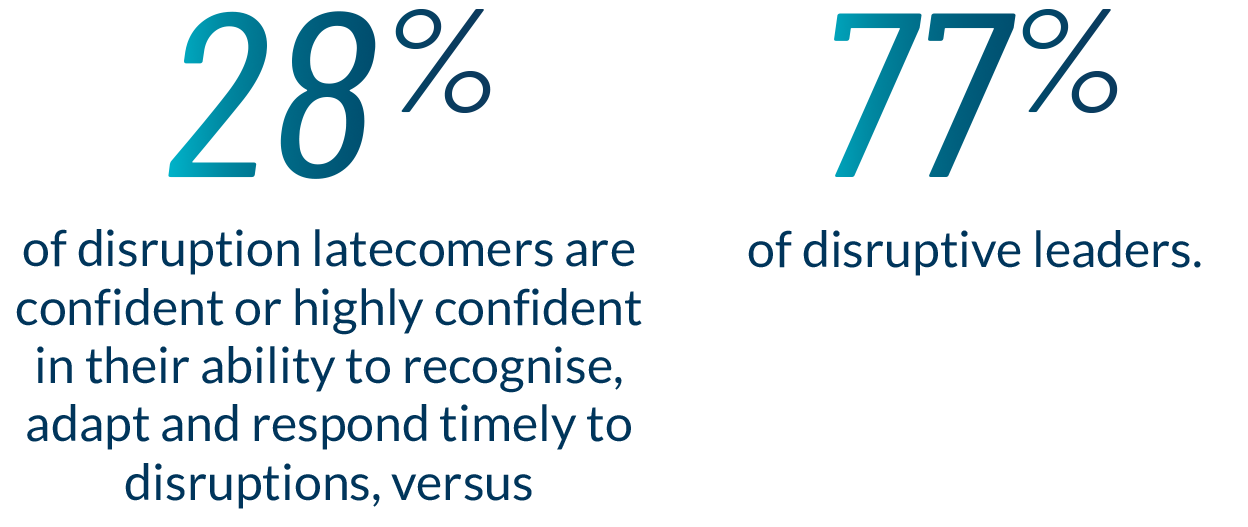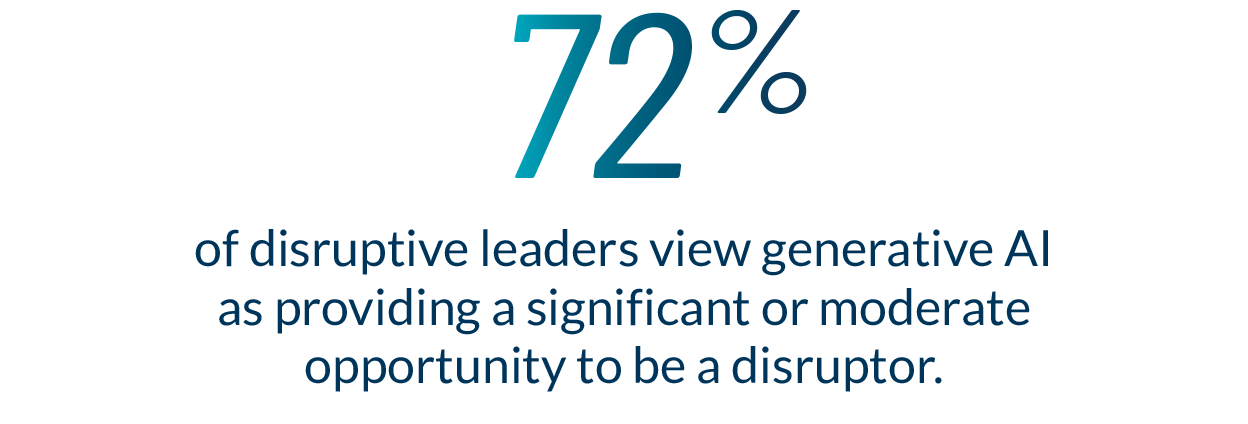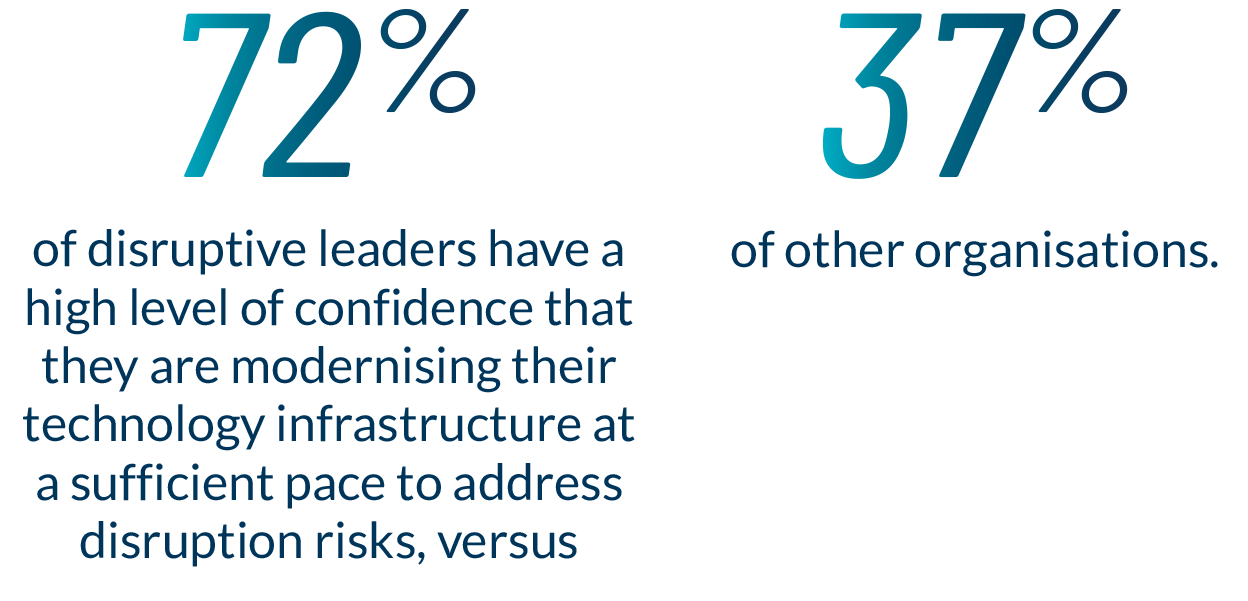Introduction

Disruptive change is happening, and more is coming. Is your organisation ready to seize the moment? This message echoes throughout the findings of our second annual Global Board Governance Survey. Our results, based on a global survey of more than 1,800 board members and C-suite executives, reveal that organisations that consider themselves to be disruptive leaders see opportunities in a changing business landscape and operate differently compared to organisations that believe they are at risk of being disrupted.

Only 15% of organisations report that their companies are disruptive leaders in their respective industries.

Key Findings
- Business models will change
- Disruptors are more prepared
- Generative AI is a litmus test
- Tech mod pace is telling
Business models will change

The half-life of organisational business models is shrinking. Our survey results reveal that more than three-quarters of all organisations expect their business model to undergo moderate to significant changes within the next 36 months. Market factors such as technological advances, geopolitical shifts, evolving customer experiences, regulatory changes, economic volatility and disruptive innovations are driving companies to adapt their business models more frequently than ever to sustain their competitive position and relevance.
Disruptors are more prepared

From their agility and innovative culture to their views on external factors that can disrupt the enterprise, organisations that are disruptive leaders see the world differently and are better prepared to embrace change.
Generative AI is a litmus test

The stakes are particularly high regarding generative AI, a disruption in which outsized impacts swing from game-changing to extremely damaging, depending on an organisation’s perceived disruptor status. Most disruptive leaders approach and leverage generative AI as an opportunity, while more than two in five disrupted organisations view generative AI as a substantial threat to their business.
Tech mod pace is telling

Of note, all survey respondents, regardless of their organisation’s disruptor status, rate the accelerating pace of technological advancement as their most significant concern in terms of external factors that may disrupt the company’s strategy and business model.


Relevant questions for directors and senior leaders
Based on our survey’s key takeaways, we offer the following questions for directors and senior executives to consider as they assess the competitive landscape, potential disruptors and their desired positioning on the disruption continuum.

The strategy and business model
+- Is our organisation truly customer-centric? For example, are we sufficiently focused on enhancing the customer experience? Is driving value for the customer central to all of our decision-making in sustaining the relevance of our business model and its underlying processes and in identifying and overcoming internal barriers to putting customer preferences and expectations first?
- Have we identified potential industry or market disruptions that may impact our strategy and business model? Have we played out the impact of these disruptive scenarios to understand the extent of their impact on our business and how best to counter them, including actions we should take near-term to prepare?
- Do we understand the most critical assumptions underlying our strategy, and are we monitoring the external and internal factors that could render one or more of those assumptions invalid?
- Do we have an early warning capability in place, such as a dashboard of vital signs or early alerts derived from ongoing analyses of disruptive scenarios and key assumptions underlying our strategy? Do we monitor the dashboard for changes in markets and customers as well as the economy and competitive environment, just as we monitor the execution of the strategy itself?
- Are we prepared to implement changes to our strategy and business model that may be necessary to respond to disruptive trends and events or when one or more of our strategic assumptions are no longer relevant? Do our decision-making processes support high-velocity, quality decisions that enable us to be agile and resilient?
- Do we have the leadership, talent and skills in place to navigate change and execute the necessary adjustments to our business model and strategy? If not, how are we filling the gaps to build and sustain a workforce that is resilient and equipped with diverse skills, perspectives and a high level of change readiness? Are we regularly assessing our digital capabilities as a core competency?
- Are we leveraging customer, market and other insights to inform data-driven decisions regarding customer preferences, competitor actions and operational improvements? Are feedback loops in place to engage customers, suppliers and other external parties that broaden employee participation, invigorate the innovation process and help eliminate unconscious bias in decision-making?
AI and other technologies
+- How is the organisation currently deploying and managing the opportunities and risks relating to generative AI? What governance structures do we have in place to enable experimentation with these capabilities and implementation of selected use cases while ensuring responsible deployment? What are the legal, regulatory and ethical issues we need to address? How are we sourcing and managing the integrity of the data used by our AI models?
- How does the organisation plan to use current and emerging forms of generative AI in the future as well as other AI-related systems, such as agentic AI? If we view AI deployment as more of a risk, is our perspective constraining our realisation of the opportunities these capabilities offer?
- What changes to our organisational culture, talent strategy and technology environment are needed to harness the full value of our AI investments? Do we have the talent and skills we need to succeed? Are we investing in ongoing training and development, including necessary upskilling, to realise fully the value proposition of our technology investments?
Technology modernisation
+- Do we have a clear understanding of the lessons learned from our modernisation investments over recent years? Are we thinking out of the box and taking the best approach to modernise? For example, do we buy, build or deploy a hybrid approach? Do we have the right partners? Are we breaking down large investments into discrete, manageable components?
- Are there any barriers that impede our efforts to modernise our technology infrastructure? For example, if we face capital and resource constraints and/or scaling challenges, how are we addressing them? What is our plan for removing or overcoming any other barriers?
- What is the current level of technical debt associated with our organisation’s legacy systems? How do we assess the risks of our technical debt, particularly its impact on our ability to innovate and compete with digitally mature companies? What is our strategy for reducing our technical debt?
- What governance structures are used to evaluate and prioritise our modernisation initiatives?
Barriers to being a disruptor and responding to disruptions
+- Are there any other barriers not referenced above that hamstring our ability to respond timely to industry disruptions? What is our plan for removing or overcoming these barriers?
- Does our talent strategy enable us to inculcate an innovative organisational culture that embeds innovation into our operating model and prioritises and rewards continuous learning, experimentation, creative thinking and risk-taking?
Agility and resilience in responding to disruption
+- Is agility a core mindset in our business? Are we creating flexibility and infusing agility into our operating principles and processes to navigate inevitable change in the markets we serve?
- What do our disruption-related concerns say about our need to improve our preparedness and response readiness? How would improvements to our ability to pivot our strategy, processes and organisational structures timely in response to new opportunities or threats translate to increased C-suite and boardroom confidence in our ability to manage disruption risk? For example, are we fostering lean behaviors with an open, flexible and empowering organisational structure and flat hierarchy? Does our structure and hierarchy drive efficiencies, accelerate innovation cycles, and facilitate collaboration, communication, transparency, rapid decision-making and customer-focused execution?
- What steps do we need to take to better integrate disruption risk into our organisation’s overall risk governance, e.g., scanning the business environment, assessing potential disruptive scenarios and developing actionable response plans to mitigate risks?






